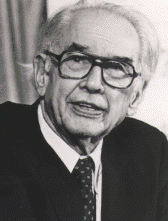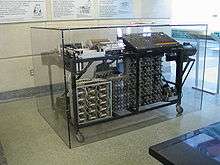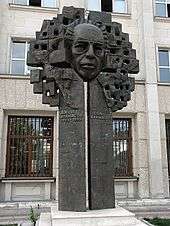John Vincent Atanasoff
John Vincent Atanasoff, OCM, (October 4, 1903 – June 15, 1995) was an American physicist and inventor, best known for being credited with inventing the first electronic digital computer.[1]
John Vincent Atanasoff | |
|---|---|
 Atanasoff, in the 1990s. | |
| Born | October 4, 1903 Hamilton, New York, U.S. |
| Died | June 15, 1995 (aged 91) Frederick, Maryland, U.S. |
| Citizenship | American |
| Known for | Atanasoff–Berry Computer |
| Awards | Order of Saints Cyril and Methodius, First Class |
| Scientific career | |
| Fields | Physics |
| Doctoral advisor | J. H. V. Vleck |
Atanasoff invented the first electronic digital computer in the 1930s at Iowa State College. Challenges to his claim were resolved in 1973 when the Honeywell v. Sperry Rand lawsuit ruled that Atanasoff was the inventor of the computer.[2][3][4][5] His special-purpose machine has come to be called the Atanasoff–Berry Computer.
Early life and education
Atanasoff was born on October 4, 1903 in Hamilton, New York to an electrical engineer and a school teacher. Atanasoff's father, Ivan Atanasoff was of Bulgarian origin, born in 1876 in the village of Boyadzhik, close to Yambol, then in Ottoman Empire. While Ivan was still an infant, Ivan's own father was killed by Ottoman soldiers after the Bulgarian April Uprising.[6] In 1889, Ivan Atanasov immigrated to the United States with his uncle. Atanasoff's father later became an electrical engineer, whereas his mother, Iva Lucena Purdy (of mixed French and Irish ancestry), was a teacher of mathematics. Young Atanasoff's ambitions and intellectual pursuits were in part influenced by his parents, whose interests in the natural and applied sciences cultivated in him a sense of critical curiosity and confidence.
Atanasoff was raised in Brewster, Florida. At the age of nine he learned to use a slide rule, followed shortly by the study of logarithms, and subsequently completed high school at Mulberry High School in two years. In 1925, Atanasoff received his bachelor of science degree in electrical engineering from the University of Florida, graduating with straight A's.
He continued his education at Iowa State College and in 1926 earned a master's degree in mathematics. He completed his formal education in 1930 by earning a Ph.D. in theoretical physics from the University of Wisconsin–Madison with his thesis, The Dielectric Constant of Helium. Upon completion of his doctorate, Atanasoff accepted an assistant professorship at Iowa State College in mathematics and physics.
Computer development

Partly due to the drudgery of using the mechanical Monroe calculator, which was the best tool available to him while he was writing his doctoral thesis, Atanasoff began to search for faster methods of computation. At Iowa State, Atanasoff researched the use of slaved Monroe calculators and IBM tabulators for scientific problems, with which controlled the Monroe using the output of an IBM. In 1936 he invented an analog calculator for analyzing surface geometry. At this point he was pushing the boundaries of what gears could do and the fine mechanical tolerance required for good accuracy pushed him to consider digital solutions.
With a grant of $650 received in September 1939 and the assistance of his graduate student Clifford Berry, the Atanasoff–Berry Computer (ABC) was prototyped by November of that year. According to Atanasoff, several operative principles of the ABC were conceived by him during the winter of 1938 after a drive to Rock Island, Illinois.
The key ideas employed in the ABC included binary math and Boolean logic to solve up to 29 simultaneous linear equations. The ABC had no central processing unit (CPU), but was designed as an electronic device using vacuum tubes for digital computation. It also had regenerative capacitor memory that operated by a process similar to that used today in DRAM memory.
Patent dispute
Atanasoff first met John Mauchly at the December 1940 meeting of the American Association for the Advancement of Science in Philadelphia, where Mauchly was demonstrating his "harmonic analyzer", an analog calculator for analysis of weather data. Atanasoff told Mauchly about his new digital device and invited him to see it.
In June 1941 Mauchly visited Atanasoff in Ames, Iowa for four days, staying as his houseguest. Atanasoff and Mauchly discussed the prototype ABC, examined it, and reviewed Atanasoff's design manuscript. In September 1942 Atanasoff left Iowa State for a wartime assignment as Chief of the Acoustic Division with the Naval Ordnance Laboratory (NOL) in Washington, D.C.; no patent application for the ABC was subsequently filed by Iowa State College.
Mauchly visited Atanasoff multiple times in Washington during 1943 and discussed computing theories, but did not mention that he was working on a computer project himself until early 1944.[7]
By 1945 the U.S. Navy had decided to build a large scale computer, on the advice of John von Neumann. Atanasoff was put in charge of the project, and he asked Mauchly to help with job descriptions for the necessary staff. However, Atanasoff was also given the responsibility for designing acoustic systems for monitoring atomic bomb tests. That job was made the priority, and by the time he returned from the testing at Bikini Atoll in July 1946, the NOL computer project was shut down due to lack of progress, again on the advice of von Neumann.
In June 1954 IBM patent attorney A.J. Etienne sought Atanasoff's help in breaking an Eckert–Mauchly patent on a revolving magnetic memory drum, having been alerted by Clifford Berry that the ABC's revolving capacitor memory drum may have constituted prior art. Atanasoff agreed to assist the attorney, but IBM ultimately entered a patent-sharing agreement with Sperry Rand, the owners of the Eckert–Mauchly memory patent, and the case was dropped.[8]
Atanasoff was deposed and testified at trial in the later action Honeywell v. Sperry Rand. In that case's decision, Judge Earl R. Larson found that "Eckert and Mauchly did not themselves first invent the automatic electronic digital computer, but instead derived that subject matter from one Dr. John Vincent Atanasoff".
Between 1954 and 1973, Atanasoff was a witness in the legal actions brought by various parties to invalidate electronic computing patents issued to Mauchly and J. Presper Eckert, which were owned by computer manufacturer Sperry Rand. In the 1973 decision of Honeywell v. Sperry Rand, a federal judge named Atanasoff the inventor of the electronic digital computer.
Postwar life
Following World War II Atanasoff remained with the government and developed specialized seismographs and microbarographs for long-range explosive detection. In 1952 he founded and led the Ordnance Engineering Corporation, selling the company to Aerojet General Corporation in 1956 and becoming Aerojet's Atlantic Division president.
In 1960 Atanasoff and his wife Alice moved to their hilltop farm in New Market, Maryland for their retirement. In 1961 he started another company, Cybernetics Incorporated, in Frederick, Maryland which he operated for 20 years. He was gradually drawn into the legal disputes being contested by the fast-growing computer companies Honeywell and Sperry Rand. Following the resolution of Honeywell v. Sperry Rand, Atanasoff was warmly honored by Iowa State College, which had since become Iowa State University, and more awards followed.
Atanasoff died in 1995 of a stroke at his home after a lengthy illness. He is buried in Pine Grove Cemetery in Mount Airy, Maryland.
Heritage
Atanasoff visited Bulgaria twice, in 1975 and 1985. He visited Boyadzik village, where his grandfather had been shot by the Ottoman Empire Turks, and was warmly welcomed by the locals and his father's relatives. He was made an honorable citizen of the town of Yambol, and received the "Key of the Town". He was also given various titles by the Bulgarian Academy of Sciences. The John Atanasov prize is awarded every year in Bulgaria. The 3546 Atanasoff asteroid found at the Bulgarian astronomic observatory of Rozen, was named after him.[9]
Honors and distinctions
Atanasoff's first national award for scientific achievements was the Order of Saints Cyril and Methodius, First Class, Bulgaria's highest scientific honor bestowed to him in 1970, before the 1973 court ruling.[10]
In 1990, President George H. W. Bush awarded Atanasoff the United States National Medal of Technology, the highest U.S. honor conferred for achievements related to technological progress.[11]
Other distinctions awarded to Atanasoff include:
- U.S. Navy Distinguished Service Award (1945)
- Citation, Seismological Society of America (1947)
- Citation, Admiral, Bureau of Ordnance (1947)
- Cosmos Club membership (1947)
- Doctor of Science (Honoris Causa) University of Florida (1974)
- Honorary membership, Society for Computer Medicine (1974)
- Iowa Inventors Hall of Fame (1978)
- Computer Pioneer Medal from the Institute of Electrical and Electronics Engineers (IEEE) (1981)
- Iowa Governor's Science Medal (1985)
- Order of the People's Republic of Bulgaria, First Class (1985)[10]
- Computing Appreciation Award, EDUCOM (1985)
- Foreign Member of the Bulgarian Academy of Sciences (1985)[12]
- Holley Medal, American Society of Mechanical Engineers (1985)
- Honorary citizen of the city of Yambol, Bulgaria (1985; Atanasoff's father was born in Yambol region)[12]
- Coors American Ingenuity Award (1986)
- Doctor of Science (Honoris Causa) University of Wisconsin–Madison (1987)
Named after Atanasoff
- Atanasoff Nunatak (a peak) on Livingston Island in the South Shetland Islands, Antarctica[13]
- The asteroid (3546) Atanasoff, discovered by the Rozhen Observatory[14][15][16]
- Atanasoff Hall, a computer science building on the Iowa State campus
- Iowa State's implementation of MIT's Project Athena ("Project Vincent", after Atanasoff's middle name)
- The John Atanasoff Award, established by Georgi Parvanov in 2003 and bestowed annually by the President of Bulgaria to a young Bulgarian for achievements in the field of computer and information technologies and the information society of Bulgaria[17][18]
- The John Atanasoff Technical College in the Bulgarian city of Plovdiv, a branch of the Technical University of Sofia[19]
- The John Atanasoff Bulgarian national tournament in informatics and information technologies, held in the city of Shumen annually since 2001[20]
- The John Atanasoff Professional High School of Electronics in the city of Stara Zagora, Bulgaria[21]
- The John Atanasoff Professional High School of Electronics in Sofia[22]
- The John Atanasoff Chitalishte (community cultural centre), Sofia[23]
- The John Atanasoff Chitalishte, Boyadzhik Village, Bulgaria (the birthplace of Atanasoff's father)[24]
- Prof. John Atanasoff 4th Primary School, Sofia[25]
- The John Atanasoff Private High School, Blagoevgrad, Bulgaria[26]
- The John Atanasoff Professional Technical High School, Kyustendil, Bulgaria[27]
- The John Atanasoff Bulgarian Language School, Chicago, Illinois,[28]
- The John Atanasoff Professional High School of Economic Informatics, Targovishte, Bulgaria[29]
- The John Atanasoff University Student Computer Club, Plovdiv University, Bulgaria[30]
- John Atanasoff Street, Yambol, Bulgaria[31]
- John Atanasoff Street, Sofia[32]
Selected bibliography
- Atanasoff, John V. (July–September 1984). "Advent of the Electronic Digital Computing". IEEE Annals of the History of Computing. 6 (3): 229–282. doi:10.1109/MAHC.1984.10028. ISSN 1058-6180.
- Atanasoff, John V. (1985). "The Beginning". Sofia: Narodna Mladezh Publishers. Cite journal requires
|journal=(help)CS1 maint: ref=harv (link) (Bulgarian version of his 1984 paper).
See also
Notes
- "ATANASOFF, JOHN VINCENT". Who's Who in America 1995. 1 (A-K) (49th ed.). New Providence, NJ: Marquis Who's Who. 1994. p. 129. ISBN 0837901596. Retrieved January 22, 2020 – via Internet Archive.
- Invitation to Computer Science. Retrieved February 8, 2014.
- John Vincent Atanasoff. The father of the computer. (October 4, 1903 – June 15, 1995)
- Kiplinger's Personal Finance. Retrieved February 8, 2014.
- Portraits in Silicon. Retrieved February 8, 2014.
- Atanasoff 1985.
- Mollenhoff 1988, p. 62–66.
- Mollenhoff 1988, pp. 81–86.
- "Minor Planet Center, object 3546". Minor Planet Center. Retrieved November 2, 2016.
- "Prof. Kiril Boyanov. John Vincent Atanasoff – The Inventor of the First Electronic Digital Computing" (PDF). Retrieved February 8, 2014.
- "Honoring Dr. John Atanasoff on the One Hundredth Anniversary of His Birth". Congressional Record – Extensions of Remarks. October 30, 2003. pp. E2159–2160. Retrieved May 15, 2009.
- Yambol Province Government. Archived June 11, 2008, at the Wayback Machine Website (in Bulgarian)
- "SCAR Composite Antarctic Gazetteer entry". Data.aad.gov.au. March 15, 2002. Retrieved February 8, 2014.
- "Minor Planet Names: Alphabetical List". Cfa.harvard.edu. Retrieved February 8, 2014.
- Schmadel 2000.
- National Military University Archived January 10, 2008, at the Wayback Machine Website (in Bulgarian)
- John Atanasoff Award Archived June 10, 2008, at the Wayback Machine
- Bestowing the 2005 John Atanasoff Award. Archived June 13, 2008, at the Wayback Machine Iowa State University website.
- John Atanasoff Technical College
- The 7th John Atanasoff Tournament. Darik News website (in Bulgarian)
- John Atanasoff Professional High School of Electronics, Stara Zagora Archived January 4, 2008, at the Wayback Machine
- John Atanasoff Professional High School of Electronics, Sofia Archived June 10, 2008, at the Wayback Machine
- Atanas Georgiev. "John Atanasoff Chitalishte, Sofia". Chitalishte.bg. Archived from the original on April 18, 2012. Retrieved February 8, 2014.
- Atanas Georgiev. "John Atanasoff Chitalishte, Boyadzhik". Chitalishte.bg. Archived from the original on October 25, 2007. Retrieved February 8, 2014.
- Prof. John Atanasoff Primary School, Sofia. Picture
- John Atanasoff Private High School, Blagoevgrad Archived February 16, 2008, at the Wayback Machine
- Страницата е генерирана за 0.55 сек. на 08.02.2014 02:54. "John Atanasoff Professional Technical High School, Kyustendil". Schools.pomagalo.com. Retrieved February 8, 2014.
- Website
- John Atanasoff Professional High School of Economic Informatics, Targovishte
- John Atanasoff University Student Computer Club, Plovdiv University Archived October 24, 2007, at the Wayback Machine
- "John Atanasoff Street, Yambol addressee". Nts-yambol.org. Retrieved February 8, 2014.
- "John Atanasoff Street, Sofia addressee". Mall.neogen.bg. Archived from the original on June 10, 2008. Retrieved February 8, 2014.
References
- Mollenhoff, Clark R. (1988). Atanasoff: Forgotten Father of the Computer. Ames, Iowa: Iowa State University Press. ISBN 978-0-8138-0032-5 – via Internet Archive.CS1 maint: ref=harv (link)
- Schmadel, Lutz D. (2000). Dictionary of Minor Planet Names. Springer-Verlag Telos. ISBN 978-3540662921.CS1 maint: ref=harv (link)
Further reading
- Anellis, Irving H. (January 1997). "John Vincent Atanasoff—His Place in the History of Computer Logic and Technology". Modern Logic. 7 (1). Retrieved June 4, 2015.
- Burks, Alice R.; Arthur W. Burks (1988). The First Electronic Computer: The Atanasoff Story. Ann Arbor, Michigan: The University of Michigan Press. ISBN 978-0-472-10090-3.
- Burks, Alice Rowe (2003). Who Invented The Computer?: The Legal Battle that Changed Computing History. Amherst, New York: Prometheus Books. ISBN 978-1-59102-034-9.
- Burks, Arthur W.; Alice R. Burks (October 1981). "The ENIAC: First General-Purpose Electronic Computer". IEEE Annals of the History of Computing. 3 (4): 310–399. doi:10.1109/MAHC.1981.10043.
- Burton, Tammara (2006). World Changer. Sofia, Bulgaria: Tangra TanNakRa Publishing. p. 271.
- Do, Hien Chris. "John Vincent Atanasoff". Virginia Tech. Retrieved June 4, 2015.
- Mackintosh, Allan R. (March 1987). "The First Electronic Computer". Physics Today. 40 (3): 25. Bibcode:1987PhT....40c..25M. doi:10.1063/1.881101.
- Mackintosh, Allan R. (August 1988). "Dr. Atanasoff's Computer". Scientific American. 259 (2): 90–96. Bibcode:1988SciAm.259b..90M. doi:10.1038/scientificamerican0888-90. PMID 3064298. Archived from the original on October 31, 2009.
- Mooers, Calvin N. (April–June 2001). "The Computer Project at the Naval Ordnance Laboratory". IEEE Annals of the History of Computing. 23 (2): 51–67. doi:10.1109/MAHC.2001.10002. ISSN 1058-6180.
- Smiley, Jane (2010). The Man Who Invented the Computer: The Biography of John Atanasoff, Digital Pioneer. Doubleday. ISBN 978-0385527132. OCLC 502029794 – via Internet Archive.
- Media
- Hollar, John (January 27, 2011). Revolutionaries: The Man Who Invented the Computer with Author Jane Smiley. YouTube (video). Mountain View, California: Computer History Museum. Retrieved June 4, 2015.
- Kang, Cecilia (November 18, 2010). After Words with Jane Smiley. C-span.org (video). National Cable Satellite Corporation. Retrieved June 4, 2015.
- Obituaries
- Parashkevov, Atanas (June 1995). "John V. Atanasoff: Obituary". Virtual Museum of Computing. Archived from the original on September 17, 2009.
External links
| Wikimedia Commons has media related to John Vincent Atanasoff. |
- JohnAtanasoff.com
- John Atansoff at the Augustana College website
- Atanasoff, Father of the Computer trailer at EyeSteelFilm
- John Vincent Atanasoff at the Iowa State University website
- John Vincent Atanasoff at the Mathematics Genealogy Project
- Author profile in the database zbMATH
- Works by or about John Vincent Atanasoff at Internet Archive
- John Vincent Atanasoff at Find a Grave
